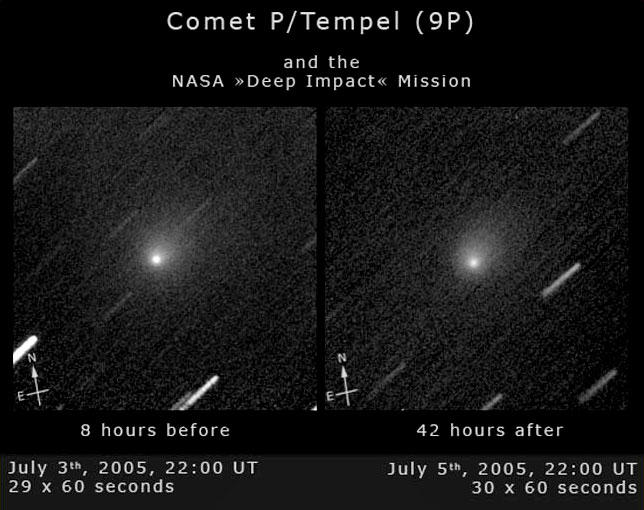|

by Wallace Thornhill
Feb 16, 2006
from
Thunderbolts Website

Credit: Image taken
in Stuttgart (Germany); special thanks to Stefan Seip.
A comparison of an image of Comet Tempel 1 taken on July 4, 2005,
0:00
CEST and one taken 2 days later reveals a return to normal activity.
More than a half-century ago, the
distinguished astronomer Fred Whipple offered a scientific theory of
comets that came to be known as the “dirty snowball model”. Embraced
by virtually all astronomers, the theory explained the “outgassing”
of comets as the effect of heating by the Sun. When a comet moves
closer to the Sun, ices on the nucleus “sublimate”, or evaporate
into space, simultaneously ejecting dusty material held within the
ices.
By the 1980s, however, new discoveries began to force changes in the
language of comets. The theorized surface water proved far more
difficult to find than anyone had imagined. In 1986, visits to
Halley’s comet by the European Giotto and Russian Vega probes failed
to locate surface water and raised the distinct possibility that the
nucleus might not be ejecting water into space. A feature story in
the journal Nature following the encounter acknowledged that,
“…only
indirect and sometimes ambiguous evidence of water has been found;
indeed, some facts seem to contradict this hypothesis”.
The flyby of Comet Borrelly by the Deep Space 1 craft in 2001
“detected no frozen water on its surface”, according to a NASA
release.
"The spectrum suggests that the surface is hot and dry. It
is surprising that we saw no traces of water ice," said the lead
investigator Dr. Laurence Soderblom.
Then, in January 2004, the Stardust spacecraft passed by Comet Wild
2, identifying a dozen jets of material exploding from the nucleus.
The craft plowed through surprisingly dense pockets of dust swirling
around the comet, but investigators were astonished that they could
not find even a trace of water on the surface, despite the energetic
activity.
By the time of “Deep Impact” on July 4, 2005, comet theory had
fragmented into mutually contradictory hypotheses—a comet was a
dirty snowball, an icy dirtball, a gravel pile, a rubble heap, or an
easily-fragmented fluffball.
NASA’s recent report on the Deep Impact mission suggests that
investigators found a smattering of water ice on the surface of
comet Tempel 1. The problem is that, to account for the water
supposedly being “exhaled” by Tempel 1, the investigators needed 200
times more exposed water- ice than they could find.
Advocates of the “electric comet” say that the issue here is not a
question of fact so much as one of interpretation. Prior assumptions
have hardened into dogma, which has prevented comet researchers from
seeing possibilities that might be obvious to those who do not share
the dogma. After noting that the surface of Borrelly was “hot and
dry”, NASA scientists did not question their theoretical starting
point.
Soderblom did not doubt the presence of water somewhere.
"We
know the ice is there," he said. "It's just well-hidden”.
Considering the pattern of new findings, it is time to pose the
question that no one has wanted to ask. Why do comet investigators
never find the levels of nucleus ices they expect? The absence of
detectable water on the nucleus of Wild 2 was particularly
mystifying because the pictures revealed cavernous craters with
steep cliffs exposing deep subsurface material. The absence of water
in such circumstance is no small problem!
The case of missing water is even more severe in the instance of
Deep Impact and Comet Tempel 1. If a thin crust of dust hides the
water below the surface of the nucleus, one would think that a newly
formed crater, estimated to be the size of a football field and
perhaps 65 feet deep, would be exactly what was needed to add life
to the comet’s water-producing ability. The ice certainly could not
be more than a few feet beneath the insulating material—and that’s
thinking generously. Any deeper than that, and the Sun’s heating
could have nothing to do with the comet’s discharge.
The explosion removed many thousands of tons of material. But prior
to impact, the calculated “water” output was 550 pounds per second;
and not long after the impact, the calculated output was, once
again, 550 pounds per second (See picture above regarding the return
to previous level). So despite the impressive explosion, the
envisioned sub-surface water refused to reveal itself. By NASA’s own
calculations, therefore, Deep Impact has only made matters worse for
standard theory.
The electrical theorists suggest that the “problem” is simply one of
scientific preconceptions—namely, unfounded assumptions about the
“water” content of the coma and its presumed origins.
More than two decades ago, Fred Whipple noted that the inner coma of
a comet is a “chemical factory” and that the complex reactions
within the coma can leave scientists “confused”. It is not clear
“whether the materials we detect come unchanged directly from the
nucleus or were manufactured near the surface”, he said.
To solve the dilemma, scientists turned to modeling the possible
chemical reactions with the help of supercomputers and spectroscopic
observations, beginning with the assumption that volatiles “boil
off” the surface via solar heating. From that starting point a
theory passed into rigid beliefs and unwarranted statements of
“fact”. As the space age has demonstrated so poignantly, the
hardened beliefs did not give way even when later visits to comets
not only failed to verify the assumptions, but produced a litany of
surprises.
No one should be permitted to state as fact the idea that large
volumes of “water” fill the comas of comets. The scientific
instruments do not see water. What they see as the most abundant
companion of cometary dust is the “hydroxyl” radical, OH.
In considering the source of OH, the theorists possess a deficient
toolkit. Standard theory has little to work with other than
photolysis, the process by which light absorption can break a
molecule down into its separate building blocks. But conventional
theorists, already “knowing” that the coma is a product of water
boiling off the nucleus, concluded with equal confidence that the
coma’s water has been broken down by the Sun’s ultraviolet
radiation, forming the hydroxyl radical (OH) along with atomic
hydrogen and oxygen. By this reasoning, the abundance of OH in a
comet nucleus becomes a direct pointer to the abundance of water
held by the nucleus.
So the distinction between fact and theory is quickly blurred. A
superabundant “leftover” of the hypothesized conversion of water
into OH is hydrogen. But in truth, it is not easy to produce
hydrogen though any process other than electrolysis. And there is a
suspicious absence of adequate experimental work to verify that the
photolysis assumed by cometologists is actually feasible on the
scale their “explanation” requires.
A much different vantage point on the water question is possible.
The unsolved mysteries of the comet will find direct answers in an
electrical exchange—the transaction between a negatively charged
comet nucleus and the Sun.
In fact there are many avenues for generating OH if you allow for
electric discharge and “sputtering” by protons to remove silicates,
carbonates, and other rock minerals, together with organic
molecules, from the comet’s surface. Electrical sputtering
technology is well established in industrial applications, but is
far from the minds of astronomers as they consider the mysteries of
the comet.
Meanwhile, the surprises continue, and the electric theorists remind
us again that surprises are the key to discovery: the findings that
have most astonished astronomers are high energy events—extreme
ultraviolet light emissions, x-ray emissions, million degree
temperatures, supersonic jets, explosive and unpredictable outbursts
even beyond the orbits of Jupiter and Saturn, the violent break-up
of comets (including the surprising speed at which the parts
sometimes separate), and the complete disintegration of comet nuclei
millions of miles from the Sun.
The very things that comet
researchers did not anticipate are the predictable effects of an
electric comet.
Of course, if electric sputtering is occurring on a comet’s surface,
it is not just another surprise; it is a challenge to all
conventional assumptions about water in the comas of comets.
Since
OH abundance is virtually the only basis for common statements about cometary water, it is essential that the question remain open long
enough to allow for consideration of the water issue from another
vantage point.
|

